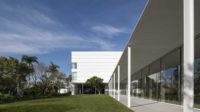Foster + Partners, together with the Spanish architect Carlos Rubio, have won a competition to rehabilitate a surviving fragment of the former royal palace of Buen Retiro in Madrid as an annex to the nearby Prado Museum. The project will restore the Baroque splendor of the "Salón de Reinos" or Hall of Realms, where King Felipe IV received foreign ambassadors in the 17th century, and will create 27,000 square feet of gallery space for temporary exhibitions. The Salón was preserved as an independent building after French troops sacked the palace during the Peninsular Wars (1808-1814).
The Foster team won the competition over seven other finalists, including teams led by David Chipperfield, Rem Koolhaas and Eduardo Souto de Moura. Other participants were Gluckman Tang of New York with the Madrid studios of Álvarez Sala and Enguita & Lasso de la Vega, and the Spanish offices of Cruz & Ortíz, Nieto Sobejano and Garces De Seta Bonet with Pedro Feduchi.
Foster's proposal raises the existing roof of the building to make way for a large gallery on the top floor, and creates a glazed atrium entry on the south facade, between the two original towers that flank the structure at each end. The atrium allows the architects to peel back later additions to the structure, and restore the Salón de Reinos' original facade and window openings. Foster presented two versions of this glass enclosure, one which opens up the existing neoclassical façade, added in the 19th century, and another that removes it entirely, replacing the structure with a line of monumental bronze columns. In both cases, the atrium roof forms an accessible terrace for the top-floor galleries.
While most of the finalists proposed modern additions or enclosures on the southern facade, the jury, headed by Rafael Moneo, singled out Foster's design for its "respect" for the "pre-existing structure", its "intelligent" solution to the "museological requirements," its "skilled integration ... into its surroundings," and its "efficient cost study."
Estimated costs are currently 32 million euros, to be financed in part by private donations.
The Salón is one of two existing fragments of the palace, both now part of the Prado's extended campus. One block to the north, the Casón del Buen Retiro conserves its ballroom, with notable ceiling frescos; it now houses the museum's Research Center. The original Prado building was in fact built as an adjunct to this complex by the neo-classical architect Juan de Villanueva in 1785. Directly behind it, Rafael Moneo's 2007 addition is organized around the ruined cloister of a former monastery, also closely associated with the palace as the site of royal retreats before it was built.
With this latest addition, the Prado thus completes an expansion plan that sketches, through this constellation of structures, the ghostly presence of the lost palace and its grounds, as can be seen in an exploded axonometric of the area prepared by the Foster team. To underscore this historical palimpsest, Foster proposes to connect the main building to the Salón and Casón via a pedestrianized street that culminates in the Retiro Park, the site of the palace's pleasure gardens.







